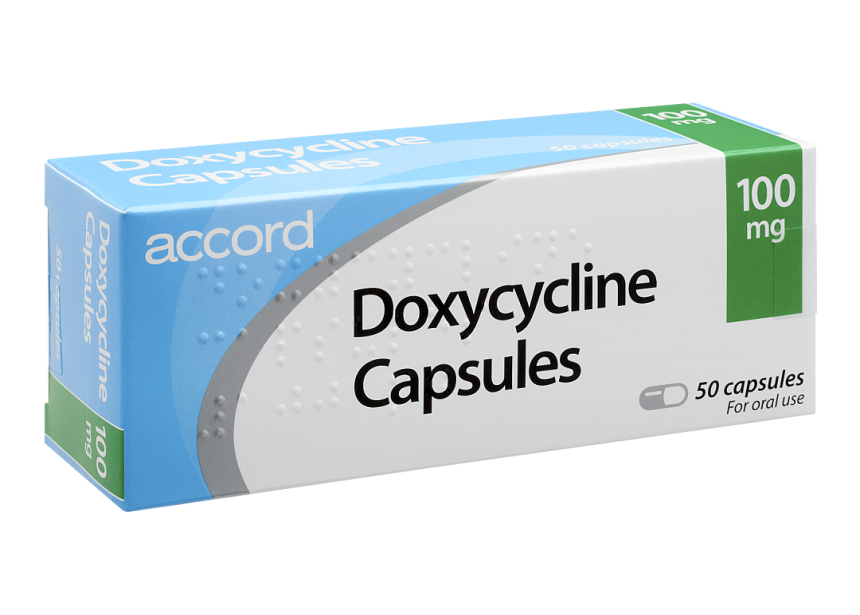
Table of contents
- What is Doxycycline?
- Indications for Doxycycline
- 1. Respiratory Tract Infections
- 2. Sexually Transmitted Infections (STIs)
- 3. Acne
- 4. Malaria Prophylaxis and Treatment
- 5. Rickettsial Infections
- 6. Lyme Disease
- 7. Other Indications
- Doxycycline Side Effects
- How to Use Doxycycline
- How to Buy Doxycycline in the USA
- 1. Get a Prescription
- 2. Choose a Pharmacy
- 3. Submit Your Prescription
- 4. Payment and Insurance
- 5. Pick Up or Receive Your Medication
- Doxycycline Prices in the USA
- Doxycycline Dosages and Their Differences
- Doctor's Recommendations for Faster Recovery with Doxycycline
What is Doxycycline?
Doxycycline is a broad-spectrum antibiotic that belongs to the tetracycline class of medications. It is used to treat a wide variety of bacterial infections by inhibiting the growth and multiplication of bacteria. Due to its effectiveness against a broad range of pathogens, doxycycline is frequently prescribed for conditions ranging from respiratory infections to acne and sexually transmitted infections.
One of the key features of doxycycline is its ability to treat both gram-positive and gram-negative bacteria, as well as atypical bacteria. This versatility makes it a valuable tool in the treatment of infections where the specific pathogen has not been identified. Additionally, doxycycline is often used in the treatment of infections caused by intracellular organisms, such as Rickettsia, which are responsible for diseases like Rocky Mountain spotted fever and typhus.
Doxycycline is also notable for its anti-inflammatory properties, which contribute to its effectiveness in treating conditions like acne. By reducing inflammation and bacterial growth, doxycycline helps to manage and alleviate the symptoms of severe acne. This dual action makes it a preferred choice for long-term acne treatment compared to other antibiotics that only target bacterial infections.
In addition to its use in treating bacterial infections, doxycycline is also employed as a prophylactic measure against malaria. When taken before, during, and after travel to malaria-endemic areas, doxycycline can help prevent malaria infections. Its role in malaria prophylaxis, combined with its broad-spectrum antibacterial activity, underscores the importance of doxycycline in both medical treatment and prevention strategies.
Indications for Doxycycline
Doxycycline is a versatile antibiotic with a broad spectrum of activity, making it a valuable option for treating a variety of bacterial infections. This tetracycline-class drug is used in numerous clinical scenarios due to its efficacy and ability to target both gram-positive and gram-negative bacteria.
1. Respiratory Tract Infections
Doxycycline is frequently prescribed for respiratory tract infections, including pneumonia, bronchitis, and sinusitis. Its effectiveness against common respiratory pathogens like Streptococcus pneumoniae, Haemophilus influenzae, and atypical bacteria such as Mycoplasma pneumoniae and Chlamydophila pneumoniae makes it a reliable choice for these conditions.
2. Sexually Transmitted Infections (STIs)
This antibiotic is a first-line treatment for certain sexually transmitted infections, particularly chlamydia and syphilis. Doxycycline is effective against Chlamydia trachomatis and is often used in combination therapy for syphilis, especially in patients allergic to penicillin.
3. Acne
One of the more common non-infectious uses of doxycycline is in the management of acne. Its anti-inflammatory properties, along with its ability to reduce the proliferation of Propionibacterium acnes, make it a standard treatment for moderate to severe acne vulgaris.
4. Malaria Prophylaxis and Treatment
Doxycycline is used as both a prophylactic and treatment option for malaria, particularly for travelers to regions where malaria is endemic. It is effective against Plasmodium falciparum, including chloroquine-resistant strains, making it an important tool in malaria prevention and management.
5. Rickettsial Infections
Rickettsial diseases, such as Rocky Mountain spotted fever, typhus, and scrub typhus, are effectively treated with doxycycline. Its efficacy in these potentially severe infections makes it the treatment of choice, often leading to rapid clinical improvement.
6. Lyme Disease
Doxycycline is commonly used in the treatment of Lyme disease, particularly in the early stages of infection. It is effective against Borrelia burgdorferi, the bacterium responsible for Lyme disease, and is also used for prophylaxis following tick bites in endemic areas.
7. Other Indications
Additionally, doxycycline is used in the treatment of a range of other infections and conditions. These include anthrax, Q fever, brucellosis, cholera, and certain eye infections such as trachoma and inclusion conjunctivitis. Its broad spectrum of activity and oral bioavailability make it a versatile option in both inpatient and outpatient settings.
Overall, doxycycline's diverse indications highlight its importance in contemporary medical practice. Its ability to target a wide range of pathogens, coupled with its anti-inflammatory properties, underscores its utility in treating infections and conditions beyond the capabilities of many other antibiotics.
Doxycycline Side Effects
Doxycycline, like all medications, can cause side effects. While many people tolerate it well, some may experience adverse reactions. Understanding these potential side effects is important for anyone taking this antibiotic.
Common Side Effects
- Nausea
- Vomiting
- Diarrhea
- Loss of appetite
- Skin sensitivity to sunlight (photosensitivity)
- Headache
These common side effects are usually mild and often resolve on their own as the body adjusts to the medication. Staying hydrated, taking doxycycline with food, and avoiding excessive sun exposure can help mitigate some of these effects.
Severe Side Effects
- Severe allergic reactions (rash, itching, swelling, severe dizziness, trouble breathing)
- Difficulty swallowing or severe esophageal irritation
- Severe skin reactions (e.g., Stevens-Johnson syndrome)
- Yellowing of the skin or eyes (jaundice)
- Changes in the amount of urine
- Persistent or severe headache, vision changes
If any of these severe side effects occur, it is crucial to seek medical attention immediately. These reactions can indicate serious conditions that require prompt treatment.
Long-term Use Side Effects
- Changes in tooth color (permanent discoloration in children)
- Increased pressure in the skull (intracranial hypertension)
- Yeast infections (oral or vaginal)
Long-term use of doxycycline can lead to additional side effects. For example, children who use doxycycline may develop permanent tooth discoloration. Adults may experience intracranial hypertension, which can present as persistent headaches and vision changes. Prolonged use can also disrupt normal bacterial flora, leading to yeast infections.
While doxycycline is an effective antibiotic for many conditions, awareness of its potential side effects ensures better management of any adverse reactions and promotes safer use of the medication.
How to Use Doxycycline
Doxycycline is a commonly prescribed antibiotic for various infections. Proper usage ensures its effectiveness and reduces the risk of side effects. Here are the key guidelines on how to use doxycycline.
Dosage and Administration
Always take doxycycline exactly as prescribed by your healthcare provider. The dosage may vary depending on the type and severity of the infection being treated. Typically, doxycycline is taken once or twice daily. Swallow the tablet or capsule whole with a full glass of water. Do not crush or chew the medication.
Timing and Meals
It is advisable to take doxycycline at the same time each day to maintain consistent levels in your bloodstream. You can take it with or without food; however, taking it with food or a glass of milk can help reduce the likelihood of stomach upset. Avoid taking doxycycline just before lying down to prevent irritation of the esophagus.
Duration of Use
Complete the full course of doxycycline prescribed by your healthcare provider, even if you start to feel better before finishing it. Stopping the medication early can lead to a resurgence of the infection and increase the risk of antibiotic resistance. If you miss a dose, take it as soon as you remember. If it is almost time for your next dose, skip the missed dose and resume your regular schedule. Do not double the dose to catch up.
Interactions and Precautions
Avoid taking doxycycline with antacids, calcium supplements, iron products, or laxatives within 2 hours of each dose, as these can interfere with absorption. Inform your healthcare provider of all medications, supplements, and herbal products you are taking to prevent potential interactions. Doxycycline can make your skin more sensitive to sunlight; use sunscreen and wear protective clothing when outdoors. If you experience severe side effects or signs of an allergic reaction, seek medical attention immediately.
How to Buy Doxycycline in the USA
Purchasing doxycycline in the United States requires a prescription from a licensed healthcare provider. Here are the steps to obtain and buy doxycycline legally and safely.
1. Get a Prescription
First, schedule an appointment with a healthcare provider. This can be your primary care physician, a specialist, or a provider at a walk-in clinic. During the consultation, explain your symptoms or the reason you believe you need doxycycline. The provider will assess your condition and, if appropriate, write you a prescription for doxycycline.
2. Choose a Pharmacy
Once you have a prescription, you can choose a pharmacy to fill it. In the USA, you have several options:
- Local Pharmacies: Major chains like CVS, Walgreens, and Rite Aid, as well as independent pharmacies, can fill your prescription.
- Mail-Order Pharmacies: Some insurance plans offer mail-order pharmacy services, which can be convenient and may save you money.
- Online Pharmacies: Ensure that any online pharmacy is legitimate and requires a prescription. Look for certification by the National Association of Boards of Pharmacy (NABP).
3. Submit Your Prescription
Take your prescription to the chosen pharmacy. If you are using a local pharmacy, you can bring a physical copy or have your doctor send it electronically. For mail-order or online pharmacies, follow their submission process, which typically involves uploading a scanned copy or having your doctor send it directly.
4. Payment and Insurance
If you have health insurance, doxycycline may be covered under your prescription drug plan. Check with your insurer to confirm coverage and co-pay amounts. If you do not have insurance, compare prices at different pharmacies to find the best deal. Many pharmacies offer discount programs or coupons that can lower the out-of-pocket cost.
5. Pick Up or Receive Your Medication
Once the pharmacy has processed your prescription, you can pick up the medication if using a local pharmacy. For mail-order or online pharmacies, the doxycycline will be shipped to your address. Verify the medication upon receipt to ensure it matches what was prescribed.
Doxycycline Prices in the USA
The cost of doxycycline in the United States can vary widely depending on several factors, including the pharmacy, dosage, quantity, and whether you have health insurance. Here’s an overview of what to expect when purchasing doxycycline.
1. Factors Affecting Prices
- Pharmacy Location: Prices can differ between chain pharmacies, independent pharmacies, and online pharmacies. Urban pharmacies may have different pricing compared to rural ones.
- Dosage and Formulation: Doxycycline is available in various dosages (e.g., 50 mg, 100 mg) and formulations (e.g., tablets, capsules). Higher dosages and larger quantities typically cost more.
- Brand vs. Generic: Generic doxycycline is generally much cheaper than branded versions. Both forms contain the same active ingredient and are equally effective.
- Insurance Coverage: If you have health insurance, your co-pay for doxycycline will depend on your specific plan. Without insurance, out-of-pocket costs can be higher.
2. Average Price Range
The price for a 30-day supply of doxycycline can vary. Here are some general price ranges:
- Generic Doxycycline (100 mg): Typically ranges from $10 to $40 for a 30-day supply.
- Brand-name Doxycycline: Can cost significantly more, ranging from $150 to $300 for a 30-day supply.
These prices are estimates and can vary based on the specific pharmacy and location. Discounts, coupons, and pharmacy membership programs can also affect the final price.
3. Ways to Save Money
There are several strategies to reduce the cost of doxycycline:
- Use Generic Options: Opt for generic doxycycline, which is significantly cheaper than the brand-name version.
- Shop Around: Compare prices at different pharmacies, including online options, to find the best deal.
- Discount Programs and Coupons: Many pharmacies offer discount programs or accept manufacturer coupons. Websites like GoodRx can provide coupons that reduce the cost.
- Insurance: If you have insurance, check with your provider to understand your coverage and co-pay. Sometimes, using insurance can be cheaper than paying out-of-pocket, but not always.
- Ask Your Doctor: Sometimes doctors can prescribe a higher dose that you can split, or they may know of other cost-saving options.
4. Online Pharmacies
Buying doxycycline from a reputable online pharmacy can be a cost-effective option. Ensure the online pharmacy is certified by the National Association of Boards of Pharmacy (NABP) and requires a prescription. Be cautious of extremely low prices that seem too good to be true, as they may indicate counterfeit medications.
Doxycycline Dosages and Their Differences
Doxycycline is a versatile antibiotic available in various dosages, each suited for different types of infections and treatment plans. Understanding these dosages and their specific uses helps ensure effective treatment and minimizes side effects. Here are the common dosages of doxycycline and how they differ.
1. Doxycycline 50 mg
The 50 mg dosage is often used for mild to moderate infections or for long-term use in chronic conditions. It is commonly prescribed for acne and rosacea due to its anti-inflammatory properties. Additionally, it can be used in low-dose regimens for malaria prophylaxis.
2. Doxycycline 100 mg
The 100 mg dosage is one of the most frequently prescribed forms of doxycycline. It is used for a wide range of bacterial infections, including respiratory tract infections, urinary tract infections, and certain sexually transmitted infections (STIs) like chlamydia. This dosage is also standard for treating Lyme disease and rickettsial infections such as Rocky Mountain spotted fever.
3. Doxycycline 150 mg
The 150 mg dosage is less common but is sometimes used for specific infections where a higher dose is required. This dosage can be beneficial for treating severe or persistent infections and is sometimes used in cases of acne that are unresponsive to lower doses. It may also be employed in conditions where higher systemic levels of the drug are needed.
4. Doxycycline 200 mg
The 200 mg dosage is typically used as a loading dose at the beginning of treatment to quickly achieve therapeutic levels in the bloodstream. It is often prescribed for severe infections and conditions that require rapid response, such as severe pneumonia or anthrax exposure. After the initial loading dose, treatment may continue with a lower maintenance dose.
Key Differences
- Indication and Severity: Higher doses are generally used for more severe or acute infections, while lower doses are suitable for chronic conditions and long-term use.
- Loading vs. Maintenance: Higher doses like 200 mg are often used as an initial loading dose to quickly establish drug levels, followed by lower maintenance doses.
- Frequency of Administration: Depending on the infection and patient response, doxycycline can be taken once or twice daily. Higher doses may be split into two doses to reduce side effects and maintain steady blood levels.
- Side Effects: Higher doses carry a greater risk of side effects such as gastrointestinal discomfort, photosensitivity, and esophageal irritation. Adjusting the dose can help manage these risks.
Consulting with a healthcare provider is essential to determine the appropriate dosage based on the specific infection, patient health status, and other factors. Proper dosing ensures the effectiveness of the treatment while minimizing the risk of adverse effects.
Doctor's Recommendations for Faster Recovery with Doxycycline
Doxycycline is a powerful antibiotic used to treat various bacterial infections. To ensure a speedy and effective recovery, doctors often provide specific recommendations for patients taking doxycycline. Following these guidelines can help maximize the benefits of the medication and reduce the risk of complications.
1. Follow the Prescribed Dosage
Take doxycycline exactly as prescribed by your healthcare provider. Do not skip doses or stop taking the medication early, even if you start to feel better. Completing the full course ensures that the infection is fully eradicated and helps prevent antibiotic resistance.
2. Take with Plenty of Water
Swallow doxycycline tablets or capsules with a full glass of water. This helps prevent irritation and ulcers in the esophagus. Avoid lying down immediately after taking the medication; stay upright for at least 30 minutes to ensure it passes smoothly through your digestive tract.
3. Avoid Dairy Products and Antacids
Do not take doxycycline with dairy products, calcium supplements, iron products, or antacids, as these can interfere with its absorption. Take the medication at least 1-2 hours before or after consuming these substances to ensure maximum efficacy.
4. Protect Your Skin from Sunlight
Doxycycline can make your skin more sensitive to sunlight, increasing the risk of sunburn. While taking this medication, avoid prolonged sun exposure, wear protective clothing, and use a broad-spectrum sunscreen with a high SPF. This helps prevent painful sunburns and potential skin damage.
5. Maintain Good Hydration and Nutrition
Drink plenty of fluids throughout the day to stay hydrated, as doxycycline can sometimes cause dehydration. Eat a balanced diet rich in fruits, vegetables, and proteins to support your immune system and overall health, aiding in quicker recovery.
6. Monitor for Side Effects
Be aware of potential side effects such as nausea, diarrhea, or photosensitivity. If you experience severe side effects like difficulty swallowing, persistent headaches, or signs of an allergic reaction (rash, itching, swelling), contact your healthcare provider immediately. Prompt attention to adverse reactions can prevent complications.
7. Avoid Alcohol and Smoking
Avoid consuming alcohol and smoking while taking doxycycline. Alcohol can exacerbate side effects like stomach upset and dizziness, while smoking can impair immune function and slow down recovery. Adhering to these lifestyle modifications can support the effectiveness of the treatment.
8. Rest and Recuperate
Ensure you get plenty of rest to help your body fight the infection. Adequate sleep and reduced physical exertion allow your immune system to function optimally, promoting faster healing.
9. Follow Up with Your Doctor
Schedule follow-up appointments with your healthcare provider to monitor your progress. If the infection does not improve or worsens, your doctor may need to adjust the treatment plan. Regular check-ins help ensure that the medication is working effectively and allows for timely interventions if needed.
FAQ
What is Doxycycline?
Doxycycline is a broad-spectrum antibiotic used to treat various bacterial infections, including respiratory infections, skin infections, urinary tract infections, and certain types of acne. It is also used as a prophylactic for malaria and to treat infections caused by anthrax.
How does Doxycycline work?
Doxycycline works by inhibiting the production of proteins that bacteria need to grow and reproduce. This action effectively stops the spread of the infection and allows the body’s immune system to eliminate the bacteria.
What are the common side effects of Doxycycline?
Common side effects include nausea, diarrhea, upset stomach, and sensitivity to sunlight. Less common side effects can include allergic reactions, severe headaches, and blurred vision. It is important to contact a healthcare provider if serious side effects occur.
Can I take Doxycycline if I am pregnant or breastfeeding?
Doxycycline is generally not recommended for use during pregnancy or breastfeeding due to potential risks to the fetus and infant. Consult your healthcare provider for safer alternatives.
How should Doxycycline be taken?
Doxycycline should be taken exactly as prescribed by your healthcare provider. It is typically taken once or twice a day with a full glass of water. Avoid lying down for at least 30 minutes after taking the medication to prevent irritation of the esophagus.
Are there any foods or drinks I should avoid while taking Doxycycline?
Avoid taking Doxycycline with dairy products, as they can interfere with the absorption of the medication. It is also advisable to avoid alcohol and excessive sun exposure while taking Doxycycline.
Can I take Doxycycline with other medications?
Doxycycline can interact with other medications, including antacids, blood thinners, and certain vitamins. It is important to inform your healthcare provider of all medications and supplements you are taking to avoid potential interactions.
What should I do if I miss a dose?
If you miss a dose of Doxycycline, take it as soon as you remember. If it is almost time for your next dose, skip the missed dose and resume your regular dosing schedule. Do not take two doses at once to make up for a missed dose.
How long does it take for Doxycycline to work?
The time it takes for Doxycycline to work can vary depending on the type and severity of the infection. Some patients may notice improvement within a few days, while others may need to take the medication for several weeks.
Is it safe to take Doxycycline long-term?
Long-term use of Doxycycline should be monitored by a healthcare provider to prevent potential side effects and complications. It is typically prescribed for short-term use, but in some cases, it may be necessary for chronic conditions.
How much does Doxycycline cost?
The cost of Doxycycline can vary depending on the dosage, quantity, and pharmacy. On average, a typical course of Doxycycline can range from $10 to $50 without insurance.
Is Doxycycline covered by insurance?
Most health insurance plans cover Doxycycline, but the amount of coverage can vary. It is best to check with your insurance provider to determine your specific coverage and copay amounts.
Are there generic versions of Doxycycline available?
Yes, generic versions of Doxycycline are available and are typically less expensive than the brand-name version. Generic doxycycline is just as effective as the brand-name medication.
Can I get Doxycycline at a lower cost with a discount card?
Many pharmacies offer discount cards or savings programs that can reduce the cost of Doxycycline. Additionally, online discount programs and coupons can provide significant savings on the medication.
Are there any patient assistance programs for Doxycycline?
Some pharmaceutical companies and non-profit organizations offer patient assistance programs to help cover the cost of Doxycycline for eligible patients. These programs typically require an application and proof of financial need.
Do I need a prescription to buy Doxycycline in the USA?
Yes, Doxycycline is a prescription medication in the USA. You will need a valid prescription from a licensed healthcare provider to purchase it.
Where can I buy Doxycycline in the USA?
Doxycycline can be purchased at most retail pharmacies, including chain pharmacies, independent pharmacies, and online pharmacies. It is important to buy from a reputable source to ensure you receive a genuine product.
Can I buy Doxycycline online?
Yes, Doxycycline can be purchased online from licensed pharmacies. Ensure that the online pharmacy is legitimate and requires a prescription before purchasing.
How can I ensure I am buying legitimate Doxycycline online?
To ensure you are buying legitimate Doxycycline online, use a pharmacy that is verified by the National Association of Boards of Pharmacy (NABP) or has a Verified Internet Pharmacy Practice Sites (VIPPS) seal. Avoid websites that do not require a prescription.
Can I buy Doxycycline over the counter in the USA?
No, Doxycycline is not available over the counter in the USA. It requires a prescription from a healthcare provider.
What are the common dosages of Doxycycline?
Doxycycline is commonly available in 50 mg, 100 mg, and 150 mg tablets or capsules. The specific dosage prescribed depends on the type and severity of the infection being treated.
How should I take Doxycycline?
Doxycycline should be taken exactly as prescribed by your healthcare provider. It is usually taken once or twice a day with a full glass of water. It is best to take it on an empty stomach, at least one hour before or two hours after meals.
Can the dosage of Doxycycline be adjusted?
Yes, the dosage of Doxycycline can be adjusted based on the patient's response to treatment and the presence of any side effects. Always follow your healthcare provider's instructions regarding dosage adjustments.
What is the typical duration of treatment with Doxycycline?
The duration of treatment with Doxycycline varies depending on the infection being treated. For acute infections, it is typically prescribed for 7 to 14 days. For chronic conditions or acne, longer courses may be necessary.
Can I split or crush Doxycycline tablets?
Some Doxycycline tablets can be split or crushed, but it depends on the specific formulation. Consult your healthcare provider or pharmacist before altering the form of your medication to ensure it is safe and effective.
Is it safe to drink alcohol while taking Doxycycline?
It is generally recommended to avoid alcohol while taking Doxycycline. Alcohol may reduce the effectiveness of the medication and increase the risk of side effects.
What are the potential risks of drinking alcohol with Doxycycline?
Drinking alcohol while on Doxycycline can lead to increased side effects such as stomach upset, nausea, vomiting, and dizziness. It may also impair your ability to tolerate the medication.
How long should I avoid alcohol after taking Doxycycline?
It is advisable to avoid alcohol for at least 24 hours after finishing a course of Doxycycline to ensure the medication has cleared your system.
Can moderate alcohol consumption be tolerated while on Doxycycline?
While some sources suggest that moderate alcohol consumption may not significantly interact with Doxycycline, it is always best to follow the advice of your healthcare provider.
What should I do if I accidentally drank alcohol while taking Doxycycline?
If you have consumed alcohol while taking Doxycycline and experience adverse effects or are concerned about potential interactions, contact your healthcare provider for guidance.







Leave a Reply
Your email address will not be published. Required fields are marked *